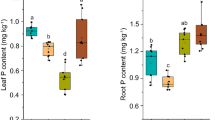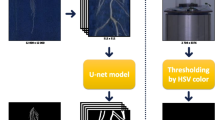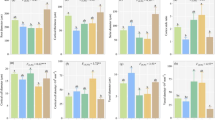Abstract
Shallow soil with low water availability, poor nutrition, and limited living space is the key limiting factor of plant growth and reproduction in vulnerable karst regions. As pioneers adapted to these areas, little is known about the reproductive responses of annual herbs to these limited soil resources. In this study, we, therefore, investigated the reproductive strategies (“fight or flight”) of two annual Asteraceae herbs (Xanthium sibiricum and Bidens pilosa) growing in the harsh karst soil environment, by comprehensively considering biomass allocation, reproductive phenology, and seed production. X. sibiricum and B. pilosa were grown under three soil depths and three water availability levels in a full two-way randomized block design, then biomass allocation, initial flowering time, fruiting stage, life span and seed number and mass were examined. In X. sibiricum, reproductive allocation decreased with decreasing water availability, soil depth, and water availability + soil depth. Meanwhile, the initial flowering time, fruiting stage and life span were all delayed with moderate decreases in resources. However, in B. pilosa, reproductive allocation increased with decreasing soil resources, while initial flowering time, fruiting stage and life span remained unchanged under moderate resource decline. Under severe resource decline, both species showed a reduction in fruiting stage and life span. These results support the hypothesis that X. sibiricum tends to adopt a “fight” reproductive strategy in response to declining resources via changes in biomass allocation, reproductive phenology and seed production. In contrast, B. pilosa tends to adopt a “flight” strategy in terms of biomass allocation, while maintaining a relatively stable reproductive phenology and seed size to cope with the harsh living conditions. However, neither species coped well under severe declines in water availability, nutrition and living space. These findings help our understanding of how herbaceous plants can adjust their reproductive strategies to support their regeneration in harsh karst soil environments.




Similar content being viewed by others
Data availability
The data and material in this paper are available.
References
Bresson CC, Vitasse Y, Kremer A, Delzon S (2011) To what extent is altitudinal variation of functional traits driven by genetic adaptation in European oak and beech? Tree Physiol 31:1164–1174
Cao GX (2007) Trade-offs of reproductive resources at hierarchical levels with reference to fruiting stage in Cardiocrinum cordatum (Liliaceae). J Southwest Univ 12:104–107
Chen L, Li YF, Su Y, Song NP, Yang XG, Wang L, Bian YY, Yang L (2018) Size-dependent reproductive allocation of Artemisia scopariain different habitats on the desert steppe. Acta Agrestia Sin 12:79–93
Chen YH, Wei Y, Guo QS, Liu L, Zhang XM, Wan DQ (2019) The characteristics of reproductive allocation of Prunella vulgaris L. populations in heterogeneous environments. Pak J Bot 4:1459–1464
Dai QH, Yan YJ (2018) Research progress of karst rocky desertification and soil erosion in southwest China. J Soil Water Conserv 2:1–10
Doust JL (1989) Plant reproductive strategies and resource allocation. Trends Ecol Evol 4:230–234
Ejsmond A, Korlowski J, Ejsmond MJ (2019) Probing of mortality rate by staying alive: the growth-reproduction trade-off in a spatially heterogeneous environment. Funct Ecol 00:1–11
Felten SV, Schmid B (2008) Complementarity among species in horizontal versus vertical rooting space. J Plant Ecol 1:33–41
Franks SJ (2011) Plasticity and evolution in drought avoidance and escape in the annual plant Brasica rapa. New Phytol 1:249–257
Franks SJ, Sim S, Weis AE (2007) Rapid evolution of flowering time by an annual plant in response to a climate fluctuation. Pans 4:1278–1282
Friedman J, Middleton TE, Rubin MJ (2019) Environmental heterogeneity generates intrapopulation variation in life-history traits in an annual plant. New Phytol 224:1171–1183
Gao CJ, Zhang TT, Tang GY, Liu FY, Li K (2018) Effects of altitude on seed size and number of Paris polyphylla var. yunnanensis. Chin J Ecol 02:366–373
Gao P, Zhang HP, Liu P, Xiao ZH, Li XH, Liu WS (2019) Effects of manganese stress on phenology and biomass allocation in Xanthium strumarium from metalliferous and non-metalliferous sites. Ecotoxicol Environ Saf 172:308–316
Gornish ES, Aanderud ZT, Sheley RL, Rinella MJ, Svejcar T, Englund SD, James JJ (2015) Altered snowfall and soil disturbance influence the early life stage transitions and recruitment of a native and invasive grass in a cold desert. Oecologia 177:595–606
Han T, Lu H, Ren H, Wang J, Song G, Hui D, Zhu S (2019) Are reproductive traits of dominant species associated with specific resource allocation strategies during forest succession in southern China? Ecol Indic 102:538–546
Hess L, Kroon HD (2007) Effects of rooting volume and nutrient availability as an alternative explanation for root self/non-self discrimination. J Ecol 95:241–251
Huang YX, Zhao XY, Zhang HX, Luo YY, Mao W (2008) Responses of Agriophyllum squarrosum phenotypic plasticity to the changes of soil nutrient and moisture contents and population density. China J Appl Ecol 12:2593–2598
Latta RG, McCain C (2009) Path analysis of natural selection via survival and fecundity across contrasting environments in Avena barbata. J Evol Biol 12:2458–2469
Lauder JD, Moran EV, Hart SC (2019) Fight or flight? Potential tradeoffs between drought defense and reproduction in conifers. Tree Physiol 7:1071–1085
Leishman MR (2001) Does the seed size/number trade-off model determine plant community structure? An assessment of the model mechanisms and their generality. Oikos 2:294–302
Li GQ, Zhao PP, Shao WS, Jin CQ, Song LX, Chen YY (2019) Effect of enclosure on reproductive allocation of wheatgrass Agropyron mongolicum populations in desert steppes. Ecol Evol 9:14023–14030
Liang MT, Xiao SM, Cai JJ, Ow DW (2019) OXIDATIVE STRESS 3 regulates drought-induced flowering through APETALA 1. Biochem Biophysica Res Commun 3:585–590
Lu Y, Zhang L, Yan HM, Ren XL, Wang JB, Niu ZG, Gu FX, He HL (2018) Spatial and temporal patterns of changing vegetation and the influence of environmental factors in the karst region of southwest China. Acta Ecol Sin 38(24):8774–8786
MacArthur RH, Wilson EO (1967) The theory of island biogeography. Princeton University Press, Princeton
MacTavish R, Anderson JT (2019) Resource availability alters fitness trade-offs: implications for evolution in stressful environments. Am J Bot 2:308–318
Manning P, Houston K, Evans T (2009) Shifts in seed size across experimental nitrogen enrichment and plant density gradients. Basic Appl Ecol 4:300–308
Moles AT, Westoby M (2006) Seed size and plant strategy across the whole life cycle. Oikos 1:91–105
Mony C, Mercier E, Bonis A, Bouzille JB (2010) Reproductive strategies may explain plant tolerance to inundation: a mesocosm experiment using six marsh species. Aquat Bot 92:99–104
Mou CX, Sun G, Luo P, Wang ZY, Luo GR (2013) Flowering responses of alpine meadow plant in the Qinghai-Tibetan plateau to extreme drought imposed in different periods. China J Appl Environ Biol 19:272–279
Obeso JR (2002) The costs of reproduction in plants. New Phytol 3:321–348
Ou ZY, Shen WH, He QF, Peng YH, Huang XR, Pang SL (2018) Species composition and diversity at different vegetation successional stages in karst areas of Pinggou County, Guangxi. GX For Sci 4:381–389
Peterson ML, Angert AL, Kay KM (2019) Experimental migration upward in elevation is associated with strong selection on life history traits. Ecol Evol 00:1–14
Prieto P, Penuelas J, Ogaya R, Estiarte M (2008) Precipitation-dependent flowering of Globularia alypum and Erica multiflora in mediterranean shrubland under experimental drought and warming, and its inter-annual variability. Ann Bot 102:275–285
Roach DA, Smith EF (2019) Life-history trade-offs and senescence in plants. Funct Ecol 00:1–9
Su WC, Zhu WX (2000) Fragility in karst mountain regions of Guizhou province. Mou Res 5:429–434
Wang Y, Du GZ, Guo SQ (2009) Trade-off between size and number of capitulum and seed in Saussurea japonica: effects of resource availability. China J Plant Ecol 04:681–688
Wang XS, Li FY, Li YH, Song X, Guo XD, Hou XY, Baoyin T (2020) The shift in the abundance of two Stipa species in response to land use change is associated with their divergent reproductive strategies. J Plant Ecol 12:722–729
Wei MH, Huang JH (2015) Reproductive output and reproductive allocation of Salicornia europaea. Tianjing Agric Sci 9:145–149
Yan DC, Wen AB, Bao YH (2008) Soil on the Qianzhong karst Plateau. Earth Environ 04:342–347
Yang YY, Kim JG (2020) Shade avoidance and reproductive strategies of an early successional species Penthorum chinense in relation to shade treatments. Plant Biol 22:494–499
Yao H, Tan DY (2005) The growth characteristics and the reproductive allocation dynamics in four ephemeral species of Trigonella. J XJ Agric Univ 3:26–29
Zhang J, Wang JM, Chen JY, Song HY, Li SH, Zhao YJ, Tao JP, Liu JC (2019) Soil moisture determines horizontal and vertical root extension in the perennial grass Lolium perenne L. growing in karst soil. Front Plant Sci 10:629. https://doi.org/10.3389/fpls.2019.00629
Zhao YJ, Zhou L, Zhang J, Song HY, Liang QH, Tao JP, Cornelissen JHC, Liu JC (2017) Do shallow soil, low water availability, or their combination increase the competition between grasses with different root systems in karst soil? Environ Sci Pollut Res 24:10640–10651
Zhao ZG, Hou M, Wang YJ, Du GZ (2020) Phenological variation of flower longevity and duration of sex phases in a protandrous alpine plant: potential causes and fitness significance. BMC Plant Boil 1:137
Zhou YC, Wang SJ, Lu HM (2010) Spatial distribution of soils during the process of karst rocky desertification. Earth Environ 1:1–7
Zhou L, Zhao YJ, Song HY, Zhang J, Tao JP, Liu JC (2018) Effects of karst soil thickness heterogeneity on the leaf anatomical structure and photosynthetic traits of two grasses under different water treatments. Acta Ecol Sin 2:721–732
Acknowledgements
We would like to thank Mr. LH Zhou for caring for the seedlings in our ecological garden. We would also like to thank Prof. Dr. JHC Cornelissen and XY Xiang for useful suggestions and proofreading of the text. This study was financially supported by grants from the National Natural Science Foundation of Chongqing (cstc2020jcyj-msxmX0244) and Fundamental Research Funds for the Central Universities (XDJK 2020B037) awarded to JC Liu and the National Key R&D Program of China (2016YFC0502304) awarded to JP Tao.
Funding
This study was financially supported by grants from National Natural Science Foundation of Chongqing (cstc2020jcyj-msxmX0244) and Fundamental Research Funds for the Central Universities (XDJK 2020B037) to JC Liu, and National Key R&D Program of China (2016YFC0502304) to JP Tao.
Author information
Authors and Affiliations
Contributions
LSH, LJC, and TJP conceived the ideas and designed methodology; LSH, SHY, and ZJ collected the data; WJM and CJY analyzed the data, LSH, LJC, LJM, LJT, and DYL co-wrote the manuscript. All authors contributed critically to the drafts and approved the final version of the manuscript.
Corresponding author
Ethics declarations
Conflict of interest
The authors declare that they have no conflict of interest.
Ethical approval
The authors declare that there is no ethics question in this paper.
Consent to participate
The authors declare their consent to participate.
Consent for publication
The authors declare their consent to publication.
Additional information
Communicated by Carissa Lyn Wonkka.
Publisher's Note
Springer Nature remains neutral with regard to jurisdictional claims in published maps and institutional affiliations.
Supplementary Information
Below is the link to the electronic supplementary material.
Rights and permissions
About this article
Cite this article
Li, S., Liu, J., Li, J. et al. Reproductive strategies involving biomass allocation, reproductive phenology and seed production in two Asteraceae herbs growing in karst soil varying in depth and water availability. Plant Ecol 222, 737–747 (2021). https://doi.org/10.1007/s11258-021-01141-5
Received:
Accepted:
Published:
Issue Date:
DOI: https://doi.org/10.1007/s11258-021-01141-5




